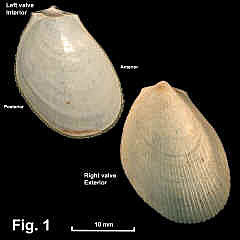|
|
LIMIDAE |
|
|
|
Limaria orientalis (A. Adams & Reeve, 1850) Description: Shape oblique oval without lunule; shell thin and fragile. Dorsal margin straight, umbo central and elevated; anterior margin initially slightly concave then rounded, ventral margin uniformly rounded, posterior margin uniformly rounded. Hinge line straight, with prominent auricles at either end, without teeth, with wide triangular depression above; ligament attached to semicircular resilifer projecting below hinge line. Interior white, margin crenulated by exterior ribs, muscle scars absent. Exterior finely radially ribbed, with secondary ribs developing in interspaces with growth. Periostracum thin, fawn. Shell colour white. Size: Up to 25 mm in height. Distribution: Port Stephens, NSW, southwards and around southern Australia to Perth, WA, including Tas. Habitat: Ludbrook (1984) gave the habitat “Found in large aggregations in nests made of mucus in fine silty sand and mud, from 5-20 m deep on low to medium energy coasts”. In NSW it is known commonly in beach washup in sheltered bays, such as Port Hacking and also trawled down to 300 m. Comparison: This species is smaller than Lima nimbifer and less oblique. The radial ribs are finer with secondaries developing between primaries with growth. Muscle scars are not apparent. Remarks: The assumption amongst present day Australian conchologists is, as with New Zealand conchologists (Grange 1974), that this species was introduced from Asia by shipping and has now become naturalised widely and integrated into natural ecosystems. Some previous authors have used Promantellum vigens Iredale, 1939, a name that Iredale applied to a specimen from Low Isles, near Cairns, Qld. Stuardo (1968) believed that the southern Australian shell required a name and, in his Ph.D. Thesis, named it Limaria imitans (Stuardo, 1968), and this name was accepted by Huber (2010). But Stuardo’s thesis was never published, and under the rules in International Code of Zoological Nomenclature a name must be produced in “an edition containing simultaneously obtainable copies” to be valid. Hence Stuardo’s name is not valid regardless of whether the underlying assumption is correct or not. Fig. 1: Simpsons Beach, Bundeena, Port Hacking, NSW (C.359589)
|
|
